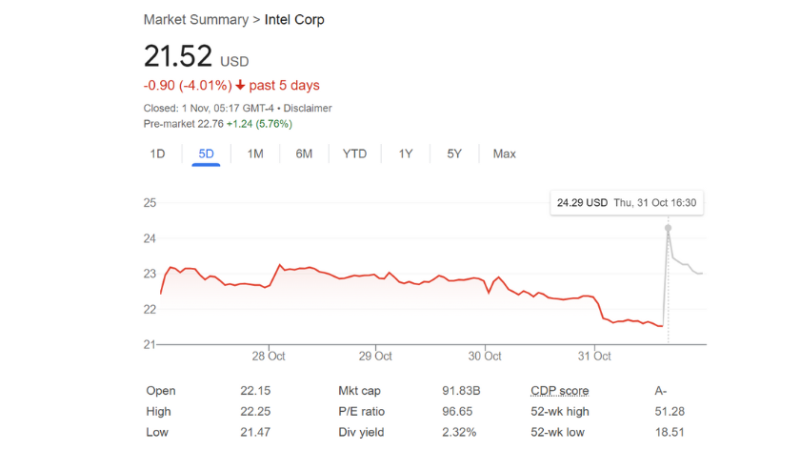Intel's Q3 figures saw its total revenue for the quarter up 6% to $13.3 billion. However, the company reported significant losses due to $18.7 billion in total charges: $15.9 billion in impairment charges and $2.8 billion in restructuring charges.
The chip giant is projecting improvements for Q4, forecasting revenues of between $13.3 and $14.3 billion, alongside a return to profitability with projected earnings per share of $0.12 — with the company suggesting fruit is beginning to bear from its structural overhaul and drastic cost-cutting.
Subscribe today for free
Intel reported revenue growth across several of its key divisions, including client computing, which increased by 7%, its data centre and AI division, which increased by 9%, and its network and edge arm, which increased by 4%.
The semiconductor firm even reported revenue growth for parts of the business it’s looking to potentially part with.
Altera, its programmable logic device manufacturing unit, saw a sizable revenue increase of 44%, while its foundry business, reportedly being eyed by Qualcomm, was up 8%.
“Our Q3 results underscore the solid progress we are making against the plan we outlined last quarter to reduce costs, simplify our portfolio and improve organizational efficiency,” said Pat Gelsinger, CEO of Intel.
In the wake of Intel’s Q3 report, the company’s stock spiked in premarket trading on Friday (November 1), rising to a peak of $24.85 a share — a price not seen since the beginning of August.

“We delivered revenue above the midpoint of our guidance, and are acting with urgency to position the business for sustainable value creation moving forward,” Gelsinger added.
It’s been a tough time for Intel of late, with the semiconductor firm having to make what its CEO called “difficult decisions” to turn its fortunes around and make $10 billion in cost reductions by 2025.
Intel’s cost-cutting measures have seen it pause expansion plans in Europe and sell off assets like its shares in chip designer Arm and its European headquarters building in the UK.
Job cuts were also part of the restructuring, with Intel announcing in August its plan to lay off some 15% of its workforce to “resize and refocus” — which equates to around 17,000 jobs.
Intel recorded hefty one-time charges in Q3, including $3.1 billion related to manufacturing asset impairments largely tied to its Intel 7 technology, $2.9 billion for goodwill impairments that primarily affected its Mobileye autonomous driving unit and $9.9 billion in tax-related charges.
Adding a further $2.8 billion in restructuring costs, the charges significantly impacted Intel’s Q3 bottom line, though the company noted these weren't included in its original Q3 guidance.
“Restructuring charges meaningfully impacted Q3 profitability as we took important steps toward our cost reduction goal,” David Zinsner, Intel’s CFO told investors. “The actions we took this quarter position us for improved profitability and enhanced liquidity as we continue to execute our strategy.”
The positive growth Intel managed to record in Q3 provides a baseline for momentum the company expects to take into Q4.
During its Q3 earnings report, Intel suggested the next quarter will yield more positive results, buoyed by factors such as a major new partnership with AWS that’s being finalised. Intel will deliver the cloud provider a custom Xeon 6 chip and a new AI fabric chip on its new 18A process as part of what Intel described as a “multi-year, multi-billion-dollar commitment.”
Intel is banking on its 18A process as being a major driver of future growth, with its flagship products, Panther Lake for clients and Clearwater Forest for servers, already meeting early milestones ahead of launches next year.
The company confirmed that its Foundry business will be split off into an independent subsidiary to provide “clearer separation” for customers and suppliers.
Intel’s foundry business posted a $7 billion operating loss on $18.9 billion in revenue in 2023, having lost ground to rivals like TSMC. By separating its Foundry business, Intel would lose a significant loss maker, meaning future revenue reports for the parent brand might be a little more positive.
“We are encouraged by improved underlying trends, reflected in our Q4 guidance,” Zinsner said.
Related stories
Intel boosts China facility with $300m despite European cutbacks
Intel: The chipmaker too big to fail?
US Government finalising Intel’s $8.5bn funding as takeover rumours swirl
Qualcomm reportedly eyes Intel acquisition: What's on the table?






